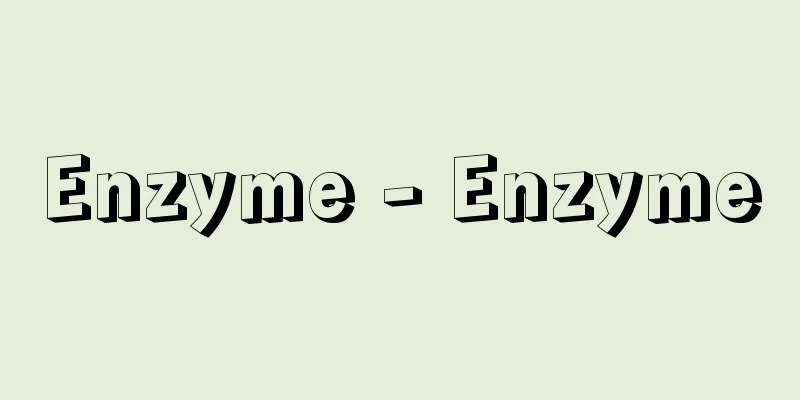Enzyme - Enzyme

|
Enzymes are catalytic proteins produced by living organisms and are also called biocatalysts. Most chemical reactions that take place in living organisms can only proceed with the help of enzymes, making them essential for life. [Kenichi Kasai] Research HistoryLiving organisms can easily carry out complex chemical reactions that would be impossible to carry out in a test tube. In the past, it was thought that this ability was due to a mysterious life force that only living organisms possessed, but a number of studies have revealed that it is due to the power of substances called enzymes. In 1752, the Frenchman R.F. Réaumur discovered that chicken stomach juices could dissolve meat, demonstrating that reactions occurring in the body could also occur outside the body. In 1833, J.F. Persaud and A. Payen isolated a substance from malt that broke down starch and named it diastase. This was the first time that enzymes were identified as substances. Eventually, pepsin was found in gastric juice, and various digestive enzymes were found in other organs. In 1878, the German physiologist Wilhelm Kühne (1837-1900) named enzymes that could be extracted outside the body in this way Enzyme (German). In addition to digestive enzymes, the French biochemist G.E. Bertrand discovered oxidase in 1894, and E. Büchner discovered an enzyme group that performed alcoholic fermentation in 1898, and it became believed that enzymes were involved in most chemical reactions performed by living organisms. In 1926, J. B. Sumner succeeded in crystallizing urease and confirmed that it was a protein. After World War II, research into the structure of enzymes made great strides, and in 1963, American biochemists W.H. Stein and S. Moore completely determined the amino acid sequence of bovine pancreatic ribonuclease, and in 1965, British David Chilton Phillips (1924-1999) and his colleagues used X-ray analysis to clarify the three-dimensional structure of egg-white lysozyme. In 1980, Yajima Haruaki, professor at the Faculty of Pharmaceutical Sciences of Kyoto University at the time, and Fujii Nobutaka, assistant professor (1950-), succeeded in the complete chemical synthesis of bovine pancreatic ribonuclease. [Kenichi Kasai] kindsEven simple organisms such as bacteria require over 1,000 types of enzymes, so the number of types of enzymes that exist in all living worlds is enormous. In order to classify and organize them rationally, the International Union of Biochemistry (now the International Union of Biochemistry and Molecular Biology) proposed a classification and nomenclature system in 1961. This system is based on the type of chemical reaction that the enzyme catalyzes. Enzymes are roughly divided into six groups, which are further subdivided ( ). As research progresses, enzymes with unexpected functions are discovered, so the system is still revised from time to time. [Kenichi Kasai] Chemical and physical propertiesWith very few exceptions, enzymes are polymers of simple or complex proteins, so their chemical and physical properties are the same as those of proteins. The molecular weight of small enzymes is about 10,000 (about 100 amino acids) and large ones can exceed 100,000 (about 1,000 amino acids), but most are in the tens of thousands. Some enzymes cannot perform catalytic action without low molecular weight compounds other than proteins. Such low molecular weight substances are called coenzymes or prosthetic groups. Although exceptional, it has been discovered that certain types of RNA (ribonucleic acid) have catalytic action, and these are called ribozymes (ribo is RNA and zyme is the suffix of enzyme). [Kenichi Kasai] Isolation and purificationEnzymes are obtained from living organisms or biological products. The methods for isolating and purifying them are essentially the same as for proteins, but because enzymes are particularly unstable, extreme care must be taken, such as handling them at low temperatures and at a neutral hydrogen ion concentration (pH). Exposure to high temperatures, strong acids or alkalis, or organic solvents can denature enzyme proteins, increasing the risk that they will lose their catalytic ability and become irreversible. In recent years, affinity chromatography methods have been developed that take advantage of the fact that enzymes bind well to substances similar to their substrates, making it possible to purify enzymes efficiently in a short period of time. Today, a large number of enzymes have been purified, and they are useful in a variety of fields. [Kenichi Kasai] Enzyme biosynthesisIn living organisms, enzymes are synthesized in exactly the same way as normal proteins. The amino acid sequences of all the enzymes that an organism possesses are recorded in its genes, or DNA (deoxyribonucleic acid), and the synthesis of the necessary enzymes is skillfully controlled when needed. [Kenichi Kasai] The role of enzymesIn order for living things to survive, countless chemical reactions must continue without a moment's rest. However, chemical reactions are very difficult to proceed under the mild conditions in which living cells live, such as temperatures below 40°C, water as a solvent, and neutral pH. Even fairly simple chemical reactions that take place in living organisms are not easy to replicate in a test tube. For example, it is difficult to perform the protein digestion (hydrolysis) that takes place in the stomach every day in a test tube without enzymes. The reaction must be heated to about 100°C for a whole day and night in hydrochloric acid that is 100 times more concentrated than that contained in gastric juice. It is even more impossible to perfectly replicate complex chemical reactions such as the synthesis of biological components in a test tube. However, in living things, countless complex chemical reactions combine with each other and proceed quickly and in a beautiful order. This is possible because each chemical reaction is guided by a properly defined enzyme. A substance that is catalyzed by an enzyme is called a substrate, and a substance that is produced by the reaction is called a product. Enzymes aid in chemical reactions, but since they themselves do not change, they can work repeatedly. Therefore, a much smaller amount of enzymes is required than the substrate. For a chemical reaction to occur in which a substrate changes into a product, the substrate must first reach an unstable state in the middle of the change. Energy is needed to reach this state, and this is called activation energy. The more energy needed for this activation, the more difficult it is for the reaction to occur. Enzymes can help the substrate reach this intermediate state with just a small amount of energy. This is called lowering the activation energy. Metaphorically speaking, to change from a substrate into a product, a high energy mountain must be overcome, but enzymes create a tunnel to quickly get to the other side. This allows the chemical reaction to reach equilibrium in a short time. This property is the same as that of ordinary catalysts; once the amounts of substrate and product reach equilibrium, the reaction cannot proceed any further. However, enzymes also have a variety of other excellent properties, as described below, and there are no other catalysts that can compare to enzymes, nor have they been created artificially. [Kenichi Kasai] Characteristics of enzymes(1) Enzymes are efficient. For example, catalase can decompose 5 million molecules of hydrogen peroxide per minute. Iron complexes can also catalyze this reaction, but the decomposition rate is only about 100,000 molecules per minute. (2) They are specific. The chemical reactions that enzymes can catalyze are strictly determined. For example, chymotrypsin and trypsin can catalyze the hydrolysis of proteins, but they do not catalyze the hydrolysis of starch or fats at all. Regarding protein hydrolysis, chymotrypsin and trypsin have different roles and break down different peptide bonds. Furthermore, these enzymes only break down peptide bonds consisting of L-type amino acids, and do not cause side reactions such as racemization. Because the substrates, products, and reaction forms of enzymes are strictly determined in this way, complex reactions take place in cells in an orderly manner without error. This is because enzyme molecules have the property of binding only to specific substrates, and only these substances can be catalyzed. (3) The action of enzymes can be regulated. The catalytic ability of enzymes can be strengthened or weakened under various conditions. For example, when a sufficient amount of a product is produced and no more is needed, the activity of the enzyme is suppressed. Conversely, when there is a deficiency of a certain substance, the necessary enzyme is activated by the action of hormones or other factors, and the substance is quickly synthesized. (4) It has an optimum temperature. Even reactions catalyzed by enzymes become faster as the temperature rises, but usually the reaction slows down once the temperature exceeds 40°C. This is because enzymes are proteins and are sensitive to heat, which destroys their three-dimensional structure and causes them to lose their enzymatic activity. The temperature at which a reaction occurs most quickly is called the enzyme's optimum temperature. (5) Has an optimum pH. The strength of an enzyme's action varies depending on the pH. The pH at which the enzyme has the strongest effect is called the optimum pH. It is usually neutral, around 7. However, the digestive enzyme pepsin, which works in a highly acidic environment such as that inside the stomach, has an optimum pH of around 2, which is well suited to its purpose. [Kenichi Kasai] Mechanism of enzyme actionAll of the above characteristics of enzymes originate from their structure as protein molecules. Today, we know the three-dimensional structures of many enzymes, which allows us to make fairly detailed predictions about how catalysis occurs. Enzyme molecules have regions that perform various roles. The most important of these is the active site. This has two main roles: one is to properly bind the substrate (specific substrate binding), and the other is to help the chemical reaction proceed (catalysis). How these are actually performed varies greatly depending on the type of enzyme, but we will explain chymotrypsin, a proteolytic enzyme, as an example. Chymotrypsin is a protein with a molecular weight of about 25,000, consisting of several hundred amino acids. Its rough shape is similar to a sphere. There is a depression in one part of the molecule (the center of the front of ), which is the active center. When this is illustrated for easy understanding, it can be divided into a substrate-binding site and a catalytic site ( ). When the substrate protein contains phenylalanine, tyrosine, or tryptophan (all of which contain aromatic rings in their side chains), this enzyme hydrolyzes the peptide bond on the carboxyl side of the substrate. Therefore, it is specific to aromatic amino acids. This is because the substrate-binding site is carved even deeper into the active site, and the aromatic rings of these amino acids fit perfectly into this site. This cave is called the substrate-binding pocket. Therefore, the substrate protein is fixed to the active site at the site of aromatic amino acids. It is not fixed at the site of other amino acids. Only once it is fixed can it be subjected to catalytic action. Hydrolysis ( ) is a reaction in which a molecule of water H2O enters between the peptide bond R1 -CO-NH- R2 and separates it into R1 -COOH and H2NR2 , but if the water molecule directly attacks this bond, it will not be able to handle it. That's where the catalytic site comes in to help. The main player here is a special serine in the catalytic site. The side chain of serine has a hydroxyl group (OH group) that is similar in structure to water, but this special serine's hydroxyl group has a much stronger bond-breaking power than water. It attacks the CO-NH bond, first breaking it off, and then hands it over to the water molecule. After completing the catalytic action, the enzyme itself remains unchanged, so if we look only at the final result, the water has broken the peptide bond, but without the help of the enzyme, this would not have happened in a mild environment like the intestine. Trypsin is a protein that is very similar to chymotrypsin. Although the three-dimensional structures of these two enzymes are very similar, trypsin cleaves only at the sites of substrate proteins that contain lysine or arginine. This is because the shape of the substrate-binding pocket perfectly accommodates amino acids with positive charges in their side chains, such as lysine and arginine. Thus, the specificity of an enzyme can be understood mainly from the properties of the substrate-binding site. [Kenichi Kasai] Use of enzymesEnzymes extracted from living organisms are used in a variety of fields. Animals and plants are also used as raw materials, but microorganisms such as bacteria and mold have many advantages, such as the ability to grow in a short period of time and the ease of obtaining varieties (strains) that produce large amounts of the desired enzyme. Recently, genetic engineering has been used to make microorganisms produce enzymes from humans and other organisms. Here are some examples of the uses of enzymes: (1) Production of useful organic substances. Even with today's advances in organic synthesis technology, it is often overwhelmingly more advantageous to use materials derived from living organisms. Therefore, it is common to look for materials in living organisms and use enzymes to convert them into the desired product. For example, starch is a polymer of glucose (grape sugar), so glucose can be obtained by hydrolysis. This is done industrially because it is much more advantageous to use starch hydrolase extracted from microorganisms than to use acids or alkalis. Also, when chemically synthesizing amino acids, in addition to the desired L-isomer, an unnecessary optical isomer called D-isomer is produced, but enzymes are used to remove them. The first step in making cheese is to coagulate milk, and an enzyme called chymosin (rennin) contained in the stomach of a calf is used for this, but the supply of this enzyme is limited. Therefore, in recent years, enzymes that perform the same function have been obtained from microorganisms and used. (2) As medicine. Giving enzymes that are deficient or have a bactericidal effect to treat illnesses is effective. Myocardial infarction and cerebral thrombosis are caused by blood clots forming in blood vessels, and can be treated by injecting a proteolytic enzyme called urokinase. This enhances the activity of an enzyme called plasmin, which is naturally present in the blood and whose original role is to dissolve blood clots. To calm inflammation, lysozyme, which dissolves pathogenic bacteria, and proteolytic enzymes, which break down and remove pus, are also used. To treat indigestion, it is effective to give takadiastase, a starch-decomposing enzyme, and pancreatin, a mixture of various digestive enzymes, or other substances. (3) As a research tool in basic science. Enzymes are indispensable reagents for investigating the structures of polymeric substances that play important roles in living organisms, such as proteins, nucleic acids, and polysaccharides. The first step in research is to use degradative enzymes with various specificities to break down these polymers into smaller molecules that are easier to handle. Without the use of enzymes, progress in life sciences would be much slower than it is today. (4) As a means of genetic manipulation. Enzymes are indispensable tools in genetic manipulation, which is rapidly advancing today. Most manipulations, such as extracting, cutting, and joining the target DNA, are aided by enzymes. It can be said that genetic manipulation began with the discovery of various enzymes between the 1970s and 1980s. (5) Others. There are still various uses. For example, to treat diabetes, the amount of glucose in the blood must be measured frequently, and one method for doing so is to use glucose oxidase. There are also various other clinical testing methods that utilize the specificity of enzymes. In recent years, from the standpoint of environmental conservation, the addition of phosphoric acid to laundry detergents has come to be avoided, and to compensate for the resulting decrease in cleaning power, detergents to which proteolytic enzymes derived from microorganisms have been added are now widely used. [Kenichi Kasai] Enzyme abnormalitiesThe synthesis of proteins, including enzymes, in the body is carried out by genetic information, but if an enzyme is missing due to a genetic abnormality, metabolism is blocked at that point, and intermediate metabolic products increase, causing congenital metabolic disorders. Representative diseases include phenylketonuria and alkaptonuria. It is also attracting attention in molecular biology, such as elucidating molecular diseases in which enzyme abnormalities cause molecules to have different molecular structures from normal. [Kenichi Kasai] FoodMany food processing uses the action of enzymes, most of which are microbial enzymes. Recently, enzymes themselves have also been applied to food. Foods that use microbial enzymes include brewed alcohol, vinegar, miso, soy sauce, natto, bread, cheese, yogurt, bonito flakes, and pickles. The main enzyme systems used in brewed alcohol are amylase and chymase. The former is supplied by koji or malt, and the latter by yeast. Sake is made by combining rice koji and yeast, and beer by combining malt and yeast. Vinegar uses acetic acid bacteria, miso uses rice koji, soy sauce uses koji mold, natto uses natto bacteria, and bread uses baker's yeast, all of which utilize the enzymes contained in bacteria. Cheese is made using an enzyme called chymosin secreted from the fourth stomach of calves and lactic acid bacteria, and yogurt uses lactic acid bacteria. Recently, enzymes have been extracted and purified from microorganisms to create enzyme preparations, which are being applied to food processing. [Miyazaki Motoyoshi] "Modern Chemistry Series 51: Enzyme Molecules" by Imahori Kazutomo et al. (1973, Tokyo Kagaku Dojin)" ▽ "Enzymes" edited by Funatsu Masaru (1976, Kodansha)" ▽ "The Function of Enzymes" by Tokushige Masanobu (1988, University of Tokyo Press)" ▽ "Bioorganic Chemistry: A Chemical Approach to Enzyme Action" by H. Dugas, translated by Imoto Yasuharu, Yamada Hidenori, and Ueda Tadashi (1993, Springer-Verlag Tokyo)" ▽ "The Chemistry of Enzymes" by Ichijima Eiji (1995, Asakura Shoten)" ▽ "New Introduction to Enzyme Chemistry" revised 2nd edition edited by Nishizawa Kazutoshi and Shimura Kensuke (1995, Nanzando)" ▽ "The Mechanism of Enzyme Reactions: Exploring the Greatest Mystery of Modern Chemistry" by Fujimoto Daizaburo (1996, Kodansha)" ▽ "Organic Chemistry of Enzyme Reactions" by Atsukichi Ohno (1997, Maruzen)" ▽ "Enzymes - The Foundations of Life Science and Biotechnology" by Eiji Ichijima (2001, Tokai University Press)" ▽ "Latest Enzyme Utilization Technology and Application Development" by Masuo Aizawa (2001, CMC Publishing)" ▽ "Nucleic Acid Enzyme Textbook for Molecular Genetics" by Kazuo Shishido (2004, Corona Publishing) [References] | | | | | | | | | | | | | | | | | | | | |©Shogakukan "> Classification of enzymes (table) Elucidated by X-ray crystallography ©Shogakukan "> Three-dimensional structure model of chymotrypsin (photo) ©Shogakukan "> Schematic diagram of bovine chymotrypsin (Figure A) ©Shogakukan "> Hydrolysis of chymotrypsin (Figure B) Source: Shogakukan Encyclopedia Nipponica About Encyclopedia Nipponica Information | Legend |
|
生物がつくりだす触媒作用をもつタンパク質で、生体触媒ともいう。生体内で行われるほとんどの化学反応は、酵素の触媒によって初めて進行するので、生命にとってはなくてはならないものである。 [笠井献一] 研究史生物は、試験管内ではとうていできないような複雑な化学反応をいとも容易に行っている。このような能力は生物だけに宿っている神秘的な生命力によるものと昔は考えられていたが、多くの研究によって酵素という物質の力によることがわかってきた。 1752年にフランスのR・F・レオミュールは、鳥の胃液が肉を溶かすのをみつけ、生体内の反応が生体外でもおこりうることを示した。1833年にJ・F・ペルソーとA・ペイアンが、麦芽からデンプンを分解する成分を取り出し、ジアスターゼと名づけた。これが酵素を物質としてとらえた最初である。やがて胃液からはペプシンが、その他の臓器からもいろいろな消化酵素がみつけられた。1878年にドイツの生理学者キューネWilhelm Kühne(1837―1900)は、このように生体外に取り出せる酵素をエンチームEnzym(ドイツ語)と名づけた。消化酵素以外では、1894年にフランスの生化学者G・E・ベルトランが酸化酵素を、1898年にE・ブフナーがアルコール発酵を行う酵素(群)をみつけ、生物の行う化学反応のほとんどに酵素が関係していると信じられるようになった。1926年にJ・B・サムナーがウレアーゼの結晶化に成功し、それがタンパク質であることを確認した。 第二次世界大戦以後、酵素の構造研究は飛躍的に進み、1963年にアメリカの生化学者W・H・スタインとS・ムーアらがウシ膵臓(すいぞう)のリボヌクレアーゼのアミノ酸配列を完全に決定し、1965年にはイギリスのフィリップスDavid Chilton Phillips(1924―1999)らが、X線解析法によって卵白リゾチームの立体構造を明らかにした。また1980年(昭和55)には当時の京都大学薬学部教授の矢島治明(やじまはるあき)と助教授藤井信孝(ふじいのぶたか)(1950― )が、ウシ膵臓リボヌクレアーゼの完全化学合成に成功した。 [笠井献一] 種類細菌のような簡単な生物でさえも1000種類以上の酵素を必要とするから、全生物界に存在する酵素の種類は膨大なものとなる。これを合理的に分類整理するために1961年、国際生化学連合(現在は国際生化学・分子生物学連合)が分類命名法を提案した。これは分類の基礎を、酵素が触媒する化学反応の型に置いている。大まかに六つの群に分け、それがさらに細分されている()。研究が進むにつれて、予想もしなかったような作用をもつ酵素がみつかったりするので、現在でもときどき修正される。 [笠井献一] 化学的・物理的性質酵素はごく一部の例外を除いて、単純タンパク質または複合タンパク質の高分子であるから、化学的・物理的性質はタンパク質の性質がそのまま当てはめられる。分子量は小さいもので約1万(アミノ酸として約100個)、大きいものでは10万(アミノ酸として約1000個)以上のものもあるが、数万程度のものがもっとも多い。ある種の酵素では、タンパク質以外の低分子化合物が存在しないと触媒作用を行えないものがある。このような低分子物質を補酵素または補欠分子族という。例外的ではあるが、ある種のRNA(リボ核酸)が触媒作用をもつことが発見されており、これらはリボザイム(リボはRNA、ザイムはエンザイムの語尾)とよばれている。 [笠井献一] 分離と精製酵素を得るには生物あるいは生物の生産物を原料とする。分離精製法はタンパク質の場合と本質的には変わらないが、酵素はとくに不安定なため、低温、中性の水素イオン濃度(pH)で取り扱うなど、細心の注意を払わなければならない。高温、強い酸やアルカリ、有機溶媒などにさらされると酵素タンパク質が変性し、触媒能力が失われて元に戻らなくなる危険性が大きい。最近は、酵素が基質に似た物質によく結合することを利用したアフィニティ(親和力)クロマトグラフィー法が発達してきたので、短時間で能率よく純化できるようになった。今日では純化されている酵素は多数に上り、さまざまな分野で役だっている。 [笠井献一] 酵素の生合成生物の体内では、酵素も普通のタンパク質とまったく同じやり方で合成されている。その生物のもっているすべての酵素のアミノ酸配列は、遺伝子であるDNA(デオキシリボ核酸)に記録されており、必要なときに必要な酵素が合成されるよう巧みに制御されている。 [笠井献一] 酵素の役割生物が生きていくためには、無数の化学反応を一瞬の休みもなく続けていなければならない。ところが化学反応というものは、生物の細胞が生きている環境、すなわち40℃以下の温度、水という溶媒、中性のpHなど、いわゆる穏やかな条件下では、非常に進行しにくいものである。生物体内で行われている化学反応のうちのかなり単純なものでさえ、試験管内でまねるのはやさしくない。たとえば、胃の中で毎日行われているタンパク質の消化(加水分解)を酵素なしで試験管内で行わせるのはたいへんである。胃液に含まれるよりも100倍も濃い塩酸の中で、一昼夜も100℃くらいに熱し続けなくてはならない。ましてや生体成分の合成のように複雑な化学反応を試験管内で完璧(かんぺき)にまねることなど不可能である。ところが生物では、無数の複雑な化学反応が互いに組み合わさりながら、みごとな秩序をもって、すばやく進行している。このようなことができるのは、一つ一つの化学反応が、それぞれきちんと定められた酵素によって導かれているからである。 酵素の触媒作用を受ける物質を基質、その反応によってつくりだされる物質を生成物とよぶ。酵素は化学反応の手助けをするが、自分自身は変化しないので、何回でも繰り返して働くことができる。したがって基質よりはるかに少ない量さえあればよい。基質が生成物に変わるという化学反応がおこるためには、基質がいったん変化途中の不安定な状態にならなければならない。この状態に到達するにはエネルギーが必要であり、それを活性化エネルギーという。この活性化に必要なエネルギーが大きいほど反応はおこりにくいことになる。酵素は、ほんの小さなエネルギーさえあれば、基質がこの中間状態に到達できるよう手助けする。これを活性化エネルギーを低下させるという。たとえていえば、基質から生成物へと変わるには、高いエネルギーの山を越えていかねばならないところを、酵素はトンネルをつくってすばやく向こう側へ行かせるのである。これによって化学反応は短い時間で平衡状態に到達できる。この性質は一般の触媒と同じであって、基質と生成物の量が平衡状態に到達したら、それ以上反応を進めることはできないが、酵素にはそのほかにも以下に述べるようなさまざまな優れた特性があり、酵素に匹敵するような触媒はほかにはなく、人工的につくられてもいない。 [笠井献一] 酵素の特色(1)酵素は効率がよい。たとえばカタラーゼがあれば、1分間に500万分子の過酸化水素が分解される。鉄の錯塩のあるものもこの反応を触媒できるが、分解速度は1分間に10万分子くらいである。 (2)特異的である。酵素が触媒しうる化学反応は厳重に決められている。たとえばキモトリプシン、トリプシンなどは、タンパク質の加水分解反応なら触媒するが、デンプンや脂肪の加水分解はまったく触媒しない。タンパク質の加水分解についても、キモトリプシンとトリプシンでは役割が違い、分解されるペプチド結合が異なっている。またこれらの酵素はL型のアミノ酸からなるペプチド結合だけを分解し、ラセミ化のような副反応もおこさない。このように酵素の基質、生成物、反応形式などが厳重に決まっているため、細胞内では複雑な反応が間違いなく、整然と行われるのである。これは酵素分子が、決まった基質とだけ結合する性質をもっていて、その物質だけが触媒作用を受けられるからである。 (3)酵素の作用は調節できる。酵素の触媒能力は、いろいろの条件で強められたり弱められたりする。たとえば、生成物が十分につくられ、もはやそれ以上必要なくなると、酵素の能力が抑えられる。逆にある物質が欠乏したときには、ホルモンなどの作用により必要な酵素が活性化され、その物質を速やかに合成する。 (4)至適温度(最適温度)をもつ。酵素に触媒される反応でも温度が上がれば反応は速くなるが、普通は40℃を超えるあたりから、むしろ反応が遅くなる。これは、酵素がタンパク質であり、熱に弱く、立体構造が壊れて、酵素としての能力が失われてしまうからである。反応がもっとも速くなる温度を、その酵素の至適温度という。 (5)至適pH(最適pH)をもつ。酵素の作用の強さはpHによって変わる。もっとも作用の強いpHを至適pHという。普通は7付近の中性である。しかし胃の中のように強い酸性の環境下で働く消化酵素ペプシンは、至適pHが2くらいであり、その目的によくかなっている。 [笠井献一] 酵素の作用機構以上のような酵素の特色は、すべてタンパク質分子としての酵素の構造に由来している。今日ではかなりの酵素の立体構造がわかっているので、どのようにして触媒作用が行われるのか、かなり詳しく推定できるようになった。酵素分子には、さまざまな役割を受け持つ部位がある。そのうちでいちばん重要なのは活性部位である。これのおもな役割は二つある。一つは基質を正しく抑え込むこと(特異的基質結合)、もう一つは化学反応の進行を手助けすること(触媒作用)である。これらが実際にどのように行われるかは、酵素の種類によって千差万別であるが、例としてタンパク質加水分解酵素であるキモトリプシンについて説明しよう。 キモトリプシンはアミノ酸が二百数十個つながった分子量約2万5000のタンパク質である。大ざっぱな形は球に近い。分子の一部(の正面中央)にくぼみがあり、ここが活性中心である。これをわかりやすいように図式化すると、基質結合部位と触媒部位に分けることができる()。この酵素は、基質となるタンパク質中にフェニルアラニン、チロシン、トリプトファン(いずれも側鎖に芳香環を含む)がある場合に、そのカルボキシ(カルボキシル)側のペプチド結合を加水分解する。したがって芳香族アミノ酸に特異的である。その理由は、活性部位のなかでさらに深く彫り込まれた洞穴状の基質結合部位があり、そこにこれらのアミノ酸の芳香環がぴったりはまるからである。この洞窟を基質結合ポケットという。したがって基質となるタンパク質は芳香族アミノ酸の所で活性部位に固定される。これら以外のアミノ酸の所では固定されない。固定されて初めて触媒作用を受けられるようになる。加水分解()はペプチド結合R1-CO-NH-R2の間に水H2Oが1分子入ってR1-COOHとH2N-R2のように切り離す反応であるが、水分子が直接にこの結合を攻撃しても手に負えない。そこで触媒部位が手助けする。ここで主役を演じるのが、触媒部位にある特別なセリンである。セリンの側鎖には水と構造の似たヒドロキシ基(OH基)があるが、この特別なセリンのヒドロキシ基は水よりも結合を切断する力がはるかに強い。これがCO-NH結合を攻撃してまず切り離し、そのあとで水分子に手渡すのである。触媒作用を完了した後は、酵素自体にはなんの変化も残らないので、最終結果だけをみれば、水がペプチド結合を切ったことになるが、酵素の助けがなければ腸内のような穏やかな環境ではおこりえなかったことである。キモトリプシンによく似たタンパク質にトリプシンがある。この二つの酵素は立体構造もそっくりであるが、トリプシンは基質タンパク質のなかで、リジンやアルギニンのある位置に限って切断する。基質結合ポケットの形が、リジンやアルギニンのように側鎖に正電荷をもつアミノ酸をぴったりとはめ込むからである。このように酵素の特異性は、おもに基質結合部位の性質から理解することができる。 [笠井献一] 酵素の利用さまざまな分野で、生物から取り出した酵素が利用されている。原料としては、動物、植物も使われるが、細菌やカビなどの微生物が、短時間で増やすことができ、目的酵素をたくさんつくる品種(菌株)を得やすいなど、有利な点が多い。最近では、遺伝子工学によって、人間などの酵素を微生物に生産させることも行われている。酵素の利用例をいくつかあげる。 (1)有用有機物質の生産。有機合成技術が今日のように進歩しても、生物に由来するものを使うほうが圧倒的に有利な場合が多い。そこで生物に材料を求め、それを酵素で目的物につくりかえることは盛んである。たとえばデンプンはグルコース(ブドウ糖)の重合したものであるから、加水分解さえすればグルコースが得られる。これには酸やアルカリを使うより、微生物からとれるデンプン加水分解酵素を使うほうがはるかに有利なので、工業的に行われている。またアミノ酸などは、化学合成では目的とするL体以外に、不必要な光学異性体であるD体までできてしまうが、それを除去するのにも酵素が利用されている。チーズをつくるには牛乳を凝固させるのが第一段階で、その際子ウシの胃に含まれるキモシン(レンニン)という酵素が使われるが、これには供給に限りがある。そこで最近は、同じ作用をする酵素を微生物から得て使っている。 (2)医薬品として。病気の治療のために欠乏している酵素を与えたり、殺菌作用がある酵素を与えると効果がある。心筋梗塞(こうそく)や脳血栓は、血管内に血栓ができて詰まるのが原因であるが、ウロキナーゼというタンパク質分解酵素を注射すると治療できる。これは、血液中にもともと存在していて、血栓を溶かすのが本来の役割であるプラスミンという酵素の働きを強めるのである。炎症を鎮めるために、病原菌を溶かすリゾチーム、膿(うみ)などを分解して除去するタンパク質分解酵素なども使われている。消化不良の治療には、デンプン分解酵素であるタカジアスターゼ、いろいろな消化酵素の混ざったパンクレアチンなどを飲ませると効果がある。 (3)基礎科学の研究手段として。タンパク質、核酸、多糖など、生物にとって重要な役割を果たしている高分子物質の構造を調べるには、酵素はなくてはならない試薬である。いろいろな特異性をもつ分解酵素で、これらの高分子を壊し、取扱いに手ごろな大きさにするのが研究の第一段階である。酵素が使えなかったら、生命科学の進歩は、いまよりもはるかに遅れていたであろう。 (4)遺伝子操作のための手段として。今日、急速に進歩している遺伝子操作でも、酵素は欠かすことのできない武器である。目的のDNAを取り出したり、切ったり、つないだり、ほとんどの操作が酵素の助けを借りている。1970年から1980年にかけて、いろいろな酵素がみつかったからこそ、遺伝子操作が始まったといってもよい。 (5)その他。まださまざまな利用法がある。たとえば糖尿病の治療のためには、血液中のグルコース量を頻繁に測定しなければならないが、その一つの方法として、グルコース酸化酵素を利用するものがある。そのほか、酵素の特異性を利用したさまざまな臨床検査法がある。また近年、環境保全の立場から洗濯用の洗剤にリン酸を加えるのを避けるようになってきたが、それによる洗浄力の低下を補うために、微生物由来のタンパク質分解酵素を添加したものが広く使われるようになっている。 [笠井献一] 酵素異常生体内の酵素を含むタンパク質の合成は遺伝子の情報によって行われるが、遺伝子の異常によって一つの酵素が欠損すると、そこで代謝がブロックされ、中間代謝産物が増加して先天性代謝異常をおこす。代表的な疾患にフェニルケトン尿症やアルカプトン尿症などがある。また、酵素異常によって正常と異なる分子構造をもつようになる分子病の解明など、分子生物学上でも注目されている。 [笠井献一] 食品食品加工には酵素の作用を利用したものが多いが、その大部分は微生物の酵素によっている。最近、酵素そのものを食品に応用することも行われている。微生物の酵素を利用した食品には、醸造酒、食酢、みそ、しょうゆ、納豆、パン、チーズ、ヨーグルト、かつお節、漬物などがある。醸造酒に利用される主要な酵素系はアミラーゼとチマーゼである。前者は麹(こうじ)または麦芽(ばくが)、後者は酵母により供給されており、清酒は米麹と酵母、ビールは麦芽と酵母の組合せによってつくられる。食酢は酢酸菌を、みそは米麹を、しょうゆは麹菌を、納豆は納豆菌を、パンはパン用酵母を用い、菌のもつ酵素を利用している。チーズは子牛の第4胃より分泌されるキモシンという酵素および乳酸菌を利用し、ヨーグルトは乳酸菌を利用してつくられる。最近は微生物から酵素を抽出、精製した酵素剤がつくられ、これを食品加工に応用することが行われている。 [宮崎基嘉] 『今堀和友他著『現代化学シリーズ51 酵素分子』(1973・東京化学同人)』▽『船津勝編『酵素』(1976・講談社)』▽『徳重正信著『酵素のはたらき』(1988・東京大学出版会)』▽『H・デュガス著、井本泰治・山田秀徳・植田正訳『生物有機化学――酵素作用への化学的アプローチ』(1993・シュプリンガー・フェアラーク東京)』▽『一島英治著『酵素の化学』(1995・朝倉書店)』▽『西沢一俊・志村憲助編『新・入門酵素化学』改訂第2版(1995・南江堂)』▽『藤本大三郎著『酵素反応のしくみ――現代化学の最大の謎をさぐる』(1996・講談社)』▽『大野惇吉著『酵素反応の有機化学』(1997・丸善)』▽『一島英治著『酵素――ライフサイエンスとバイオテクノロジーの基礎』(2001・東海大学出版会)』▽『相沢益男著『最新酵素利用技術と応用展開』(2001・シーエムシー出版)』▽『宍戸和夫著『分子遺伝子のための核酸酵素テキストブック』(2004・コロナ社)』 [参照項目] | | | | | | | | | | | | | | | | | | | | |©Shogakukan"> 酵素の分類〔表〕 X線結晶解析によって解明された©Shogakukan"> キモトリプシンの立体構造モデル〔写真〕 ©Shogakukan"> ウシ・キモトリプシンの概念図〔図A〕 ©Shogakukan"> キモトリプシンの加水分解〔図B〕 出典 小学館 日本大百科全書(ニッポニカ)日本大百科全書(ニッポニカ)について 情報 | 凡例 |
<<: Paper mulberry (Broussonetia kazinoki)
Recommend
Miya Enginkyoku - Kyuen Ginkyoku
A long Vietnamese poem written by Nguyen Gia Thieu...
Dicotyledonous plants - Dicotyledonous plants
This refers to angiosperms that have two cotyledo...
Trouton, FT
...When the heat of vaporization of 1 mole of pur...
Oiso Hills
Also known as the Yurugi Hills. A hill in the sout...
Via Valeria
One of the important ancient Roman roads that conn...
Mount Gomadan
This mountain is located in the northeastern part...
American League
One of the major leagues at the top of American p...
Parysatis
…Xerxes II, who succeeded his father, was killed ...
Girikugai - Girikugai
...In particular, in many places, visiting or att...
Hydroquinone - Hidorokinon (English spelling) hydroquinone
A dihydric phenol. It is also called hydroquinone...
Champā (English spelling) Champa
…Located on the south bank of the Ganges River. C...
Dosimeter - Senryo-kei (English spelling) dosimeter
Among the devices that measure radioactivity, thi...
Kaan decomposition
→ Ammonolysis Source: Shogakukan Encyclopedia Nip...
Struggle against the Eels Statement - Eels Statement Opposition Struggle
... As the Cold War intensified, the occupation p...
Climate zone
Zones with similar climates that surround the Ear...









